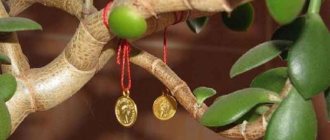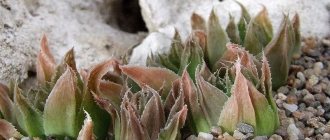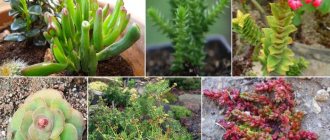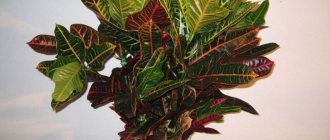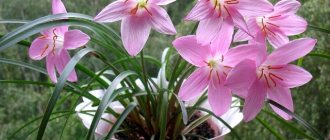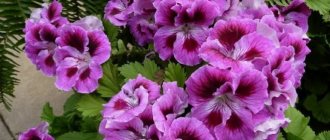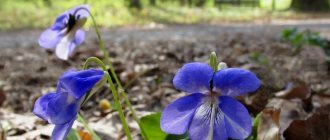Description
The Crassula genus includes more than 300 species of succulent plants from the Crassula family, growing naturally in regions with tropical and subtropical climates. More than 150 species are native to South Africa.
The variety of forms of the representatives of the genus is amazing - from tiny moss-like annual plants to tree-like large succulents 3 m high, such as Crassula ovata. Some of them are so different from each other that it is difficult to assume their relationship.
Below you can get acquainted with some popular types of culture.
Diseases and pests
The Perforata variety is subject to the same misfortunes as other indoor flowers:
| Problem | Solution | Prevention |
| Root rot | Transplantation, disinfection with activated carbon | Moderate watering |
| Mealybug | Rubbing with alcohol | Quarantine of new plants |
| Shchitovka | Removal and treatment with Actellik | Quarantine |
| Spider mites, aphids | Treatment with Fitoverm or Actellik | Regular spraying with water, ventilation |
Types of Crassula, description and photo
Crassula ovata or oval (Crassula ovata) . The most popular tree-like succulent, commonly known as the “Money Tree” or “Happiness Plant”.
It is a large, well-branched and compact tree or shrub, reaching a height of 3 meters in nature.
The branches are thick and short, the leaves are fleshy, smooth, ovate or rounded, dark green in color, often with a red tint along the edges.
Breeders have developed a wide variety of varietal forms and cultivars of Crassula ovata.
Crassula the Hobbit
The most famous in floriculture: Crassula "Hobbit" with leaves of an unusual shape, similar to tubes, a variegated green-yellow hybrid of "Vfriegata" and "Hummel's Sunset" with leaves painted in shades of green, yellow, orange and red, miniature lemon-red " Crosbys Compact" and Crassula "Minor" with glossy green, fleshy leaves with reddish edges.
The better the lighting, the brighter the leaf pattern of variegated forms becomes.
Pyramid Crassula (Crassula pyramidalis) and its unusual cultivar “Buddha Temple”. This species grows quite slowly. The roots are thin, short, collected in a bunch. Grows straight up, branching at different heights. The leaves are very hard, flat, small, uniform in size and triangular in shape. They closely overlap each other, creating a perfect four-sided column with a diameter of 12 mm.
In full sun, the upper leaves can take on a beautiful reddish hue. The flowers are small, sweet, fragrant, appearing at the top of the shoot. Unfortunately, the plant dies after flowering, but at home Crassula of this species rarely blooms.
Crassula perforata and its amazing variety “Jade Necklace”.
A small shrub with small shoots consisting of gray-green leaves, as if strung on a thread. Variegated form with pink-yellow leaves.
Crassula Morgan Beauty is a magnificent hybrid of Crassula falcata and Crassula mesembrianthemopsis. This is the case when the decorativeness of the foliage competes with the spectacular and lush flowering. The compact plant grows to only 15 cm.
The leaves are large, fleshy, flat, silver-green or bluish-gray.
What flowers should you keep in the house?
The tiny bright pink or coral flowers are borne in large, dense clusters that rise above the foliage in midsummer. The flowers open one after another, so the colorful flower show lasts almost a month.
Crassula 'Dorothy' is an amazing dwarf and slow-growing hybrid that comes in the form of thick, round rosettes that shrink easily. White flowers appear in autumn, and each of the many rosettes develops a flower stalk, so the flowering is profuse.
Crassula umbella 'Wine Cup' is a stunning Crassula variety. Its height is 15 cm, on straight short stems there are leaves fused into a rounded cap with raised edges around the stem, therefore the name of the species is translated as “wine cup”. The flowers are small, yellowish-green, collected in inflorescences, appear in winter.
Crassula umbella “Wine Cup” is a stunning Crassula variety. Its height is 15 cm, on straight short stems there are leaves fused into a rounded cap with raised edges around the stem, therefore the name of the species is translated as “Umbrella”, and the variety as “Wine Cup”.
The flowers are small, yellowish-green, collected in inflorescences, appear in winter.
Due to its low maintenance, it is a very popular choice for indoor floriculture and can be used as a scenic addition to succulent arrangements, as well as being great for bonsai art.
Diseases and pests
There is little information about the parasitic fauna that infects the Marnier crassula. Like other species, it can be harmed by spider mites and thrips. First aid for the plant is treatment with a solution of laundry soap, and then you need to act depending on the degree of damage and use acaricides or systemic insecticides.
Flower growers with experience in growing succulents warn about possible rot that occurs from regular waterlogging of the soil mixture in conditions of low room temperature and poor air circulation. For the same reason, mold appears on the ground, and then on the leaf beads. Powdery mildew was also observed. At the first symptoms, the plant is treated with an appropriate fungicide.
Caring for Crassula at home
Soil type
A well-drained and light soil type is of great importance for the plant. It is important to note that it should not contain peat, as it retains a large amount of moisture.
In nature, fat plants prefer arid and rocky places; therefore, when growing this flower, soil mixtures intended for succulents are used.
Watering
Caring for Crassula at home includes following the watering regime. All representatives of the genus belong to drought-resistant plants. After watering, the soil must be completely dry before it can be moistened again. In winter, watering is reduced to once every 7-10 days.
See also: Indoor Croton how to care
During the hot summer period, it is enough to water once every three days. If you notice that the leaves turn yellow and fall off, it is most likely that there is an excess of moisture in the flowerpot. If a succulent does not receive enough moisture, its leaves will wrinkle.
Remember that the flower can easily tolerate drying out of the soil, but an excess of water when watering and high air humidity will be detrimental to it.
Sunlight and temperature
The culture loves bright lighting (4-5 hours a day), but without direct sunlight. These succulents cannot tolerate extreme heat. Loss of foliage and burns are a consequence of negative exposure to direct sunlight over a long period of time.
The optimal summer daytime temperature is 23-25 °C, and the nighttime temperature is up to 10 °C. This difference between day and night temperatures is beneficial for the succulent because it resembles its natural conditions.
During the winter rest period, the plant needs a cooler temperature in the range of 12-16 °C during the day; the fat plant can withstand a temperature drop of up to 7 °C, but this is its extreme limit.
The culture responds gratefully to exposure to fresh air, so if possible, take the flower pot to the balcony or terrace in warm weather. A lot of light, a lack of water and fairly cool conditions promote flowering.
Top dressing
During the growing season, fertilizing with mineral fertilizers for succulents is carried out according to the manufacturer's instructions.
In winter, there is no need to apply fertilizers, since during this period the plant is dormant.
Transfer
Since almost all types of crops grow quite slowly, replanting is carried out once every 2-3 years in a wide pot, since the roots of the crop are superficial.
Basic rules for replanting plants
With age, the root system of large tree-like crassulas weakens, and the crown becomes heavier with fleshy foliage, so a stable container is necessary for a money tree. At the bottom of the pot it is necessary to pour a drainage layer of expanded clay.
Crassula bonsai
Crassulas, especially tree-like varieties, are ideal for growing in the bonsai style, as the succulent shoots can withstand careful shaping. It is best to start with planted young plants obtained from rooted cuttings.
So that all the energy goes into forming the trunk, we plant it in a small, small but heavy pot. Several cuttings tucked together can, over time, create a beautiful grouping like a tiny forest.
Now the important task is to form the crown of the tree with miniature leaves, which is achieved by constantly pruning and pinching a new growth point, each time forcing the plant to branch out more.
As soon as you see the beginning of the growth of a new bud, immediately remove it carefully so as not to damage the sensitive stems. Two kidneys should appear in place of the removed kidney.
How to grow figs at home
When a mature tree is formed, any branches growing directly upward or downward are removed. The removed stems should have at least 4-5 leaves.
To maintain the plant at approximately the same size, it is necessary to trim the overgrown roots at the time of replanting. This will help develop a thick main trunk. We take a pot of the same size.
Trimming
Pruning is an important aspect in caring for Crassula at home. The procedure is mainly relevant for Crassula ovata and species with creeping or hanging shoots. Ideally, it should be carried out in the spring.
The procedure helps strengthen and rejuvenate the succulent, as well as stimulate new growth of the main stem and root system. For the Money Tree, pruning strengthens the side branches, helping them hold heavy leaves and form a compact, lush crown.
Reproduction
Crassula is easily propagated by leaf and stem cuttings. To root them, use a mixture based on soil for succulents and coarse sand in a ratio of 1:3. Pour a layer of sand on top of the soil mixture, about 5 cm. The procedure can be carried out in spring and summer.
To obtain cuttings, we cut off young shoots 5-6 cm long. We remove the lower leaves and dry the cuttings in a dark place for 1-2 days, then bury them in slightly moist soil. Seedlings quickly take root at a temperature of 23-25 ̊C in diffused sunlight.
Cuttings also quickly form roots in water, after which they are transplanted directly into pots.
For propagation by leaf cuttings, take healthy, developed leaves. They are buried in moist soil mixture. After a few weeks, new leaves and roots of young fat plants develop along the edges of the leaves in contact with the ground.
When they reach a few centimeters in height, they can be separated from the parent leaf and treated as individual plants.
Problems in growing
In a shady place, the plant's shoots become elongated and weaken. Poor succulent growth can also be caused by excess nutrients. Excessive watering and too low a temperature will quickly lead to the development of trunk and root rot and leaf loss. Crassula also responds to lack of moisture and high temperature by falling leaves. Brown, wrinkled spots on the leaves indicate insufficient watering.
How to make proper drainage
The most common fungal disease of Crassula is powdery mildew. A white coating appears on the leaves and young shoots, the leaves begin to fall off, and the young leaves become deformed.
The development of the disease is promoted by high humidity, water getting on the leaves, along with poor air circulation. In this case, the plant must be treated with a fungicidal preparation.
The money tree may become affected by pests such as mealybugs, aphids or spider mites.
Diseases of flowers - photos and descriptions
Pests can be easily removed by wiping the affected parts with a cotton swab dipped in alcohol or a soap solution to kill scale insects and aphids. The process must be repeated every day until complete recovery.
The plant is very sensitive to insecticides, so be careful when using these products.
Author: Yulia Zakrevskaya
- Decorative foliage
- Unpretentious
Comments
Tatyana 02/17/2013 14:06 mine grew gradually on the north window, the trunk and leaves were proportional, after I read about the sun, I exposed it and felt sorry for the trunk, it grew very quickly in height and the leaves began to fall off and spots formed on them, then There was a threat of the stem breaking; I had to break off all the stems, which were bending like rubber.
Answer
Natasha 02/26/2013 14:36 For some reason, my flower’s leaves have become limp. What about him? Maybe reduce watering?
Answer
Irina 02/28/2013 06:07 I quote Natasha:
For some reason my flower's leaves have become limp. What about him? Maybe reduce watering?
If you think you are watering too much, try reducing it.
And my money tree behaves like this when I dry it out - the leaves become limp and wrinkled. Reply Valentina 03/01/2013 12:27 The plant is mature, powerful, but has never bloomed. What is the reason?
Answer
Irina 03/02/2013 16:08 I quote Valentin:
The plant is mature, powerful, but has never bloomed. What is the reason?
Firstly, Crassula begins to bloom from 3-5 years of age.
Secondly, it must be well cared for - sufficient watering, lighting, fertilizing. Crassula is one of those plants in which flower buds are formed during the dormant period. At home, it will have to be created artificially. In September-October, gradually reduce watering of Crassula and move it to a cooler room with a temperature of 10-15 degrees. Do not water it at all for a month. Don't worry, she won't die. Even if the leaves wrinkle a little, they will recover when watering is resumed. After a month, you can bring Crassula out of dormancy by raising the temperature and gradually increasing watering. But still, this plant is kept more as an ornamental foliage plant, because its flowers are small and inconspicuous. Reply Valentina 03/03/2013 00:05 Thank you very much for the advice, I’ll try in the fall.
Answer
Lyudmila 04/27/2013 23:27 And my tree is good, the leaves are juicy and elastic. But for some reason they began to fall off, just some kind of leaf fall. Even the young shoots fall off. They don’t wither, don’t dry out, but just good leaves fall. It’s standing near the window, there’s enough light. Feed it. Maybe it’s time to replant?
Answer
Lyudmila 04/27/2013 23:29 Help with advice, please. I feel so sorry for him, I love this tree so much.
Answer
Irina 04/28/2013 11:20 I quote Lyudmila:
And my tree is good, the leaves are juicy and elastic. But for some reason they started to fall off, like some kind of leaf fall. Even the young shoots fall off. They don’t wither, they don’t dry out, but just good leaves fall. It’s standing near the window, there’s enough light. I feed it. Maybe it’s time to replant?
Stop feeding her for a while until her condition returns to normal.
Only completely healthy plants are fed. The reason for the loss of good leaves may be the flooding of the plant. Crassula does not like frequent heavy watering. Try not watering it for a few days, maybe a week. At this time, spray with Epin - it increases the resistance of plants to stressful situations. Reply Lyudmila 04/28/2013 23:36 I water once a week. Is this often? Need it less often? I will definitely buy the drug. Thank you very much.
Answer
Irina 04/29/2013 03:50 I quote Lyudmila:
I water once a week. How often? Need it less often? I will definitely buy the drug. Thank you very much.
Lyudmila, a plant’s need for watering cannot be measured by quantity.
Much depends on the size of the pot and the size of the root system, as well as the health of the plant. If the pot is large and the root is small, then the soil will remain wet for a long time, since the roots do not have time to absorb all the water in a short time. This is where the bay comes from. And when a plant is sick, it also drinks little water. The top layer of soil must dry out 2-3 cm deep between waterings. Reply Update list of comments
Peculiarities of reproduction of Crassula
Succulents are propagated by side shoots, leaves and seeds. Some species grow aerial roots on fragments of the trunk, which simplifies the task. Each of the practiced methods finds admirers depending on the indications for use and personal preferences.
Some people like to cross-pollinate flowers, collect the seeds themselves and feel like a breeder, while others like to take the easy route and buy ready-made samples from professionals. The impatient choose the accelerated vegetative method.
Reproduction by cuttings and leaves
When cuttings, parts of the plant are left on the window to dry the damaged tissues for 5–30 days to avoid further decay, then planted in the ground (perlite, vermiculite, sand), and placed in a room with diffused light. Stem cuttings take root within one to four weeks. Water after the top layer of soil dries. To stimulate root formation, Kornevin or Heteroauxin is used, although this is not necessary.
When propagating by leaf, it is broken off entirely and placed on the loosened surface of the soil of a neighboring pot. After 10–20 days, roots are formed, followed by the development of reproductive buds, which were already in the bud at the base of the leaf.
In two to three months the rosette grows. It uses the nutrients from the mother's part. As the baby takes root, the leaf dies. If breeding was carried out in sand, vermiculite or perlite, young plants are transplanted into the ground after establishment. You can buy it in a specialized store or make it yourself in the following proportions:
- 1 part of garden soil + an equal amount of bottom decomposed peat;
- soil suitable for garden flowers mixed with coarse river sand;
- any substrate mixed with black peat and perlite, vermiculite or foam chips in equal parts.
The diameter of the pots is 5–7 cm, watered after the substrate has completely dried. Within six months, a young Crassula grows. Succulents reproduce successfully from spring to late summer. Autumn and winter cuttings suffer from lack of light and rot in damp soil.
If the mother leaf is torn off without a growth point, it is overgrown or old, rooting will not take place!
